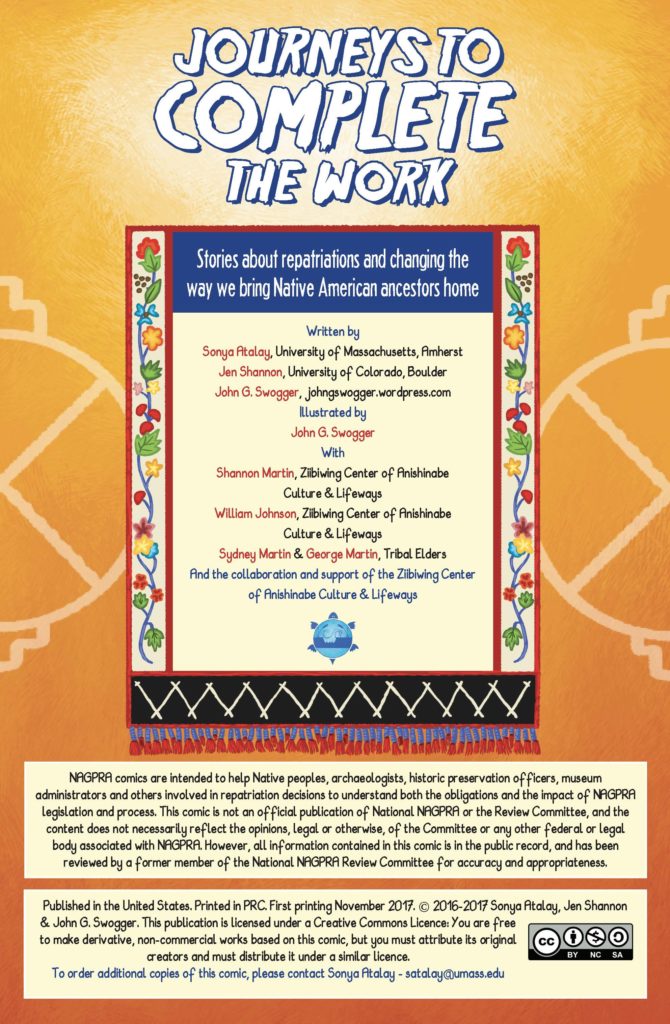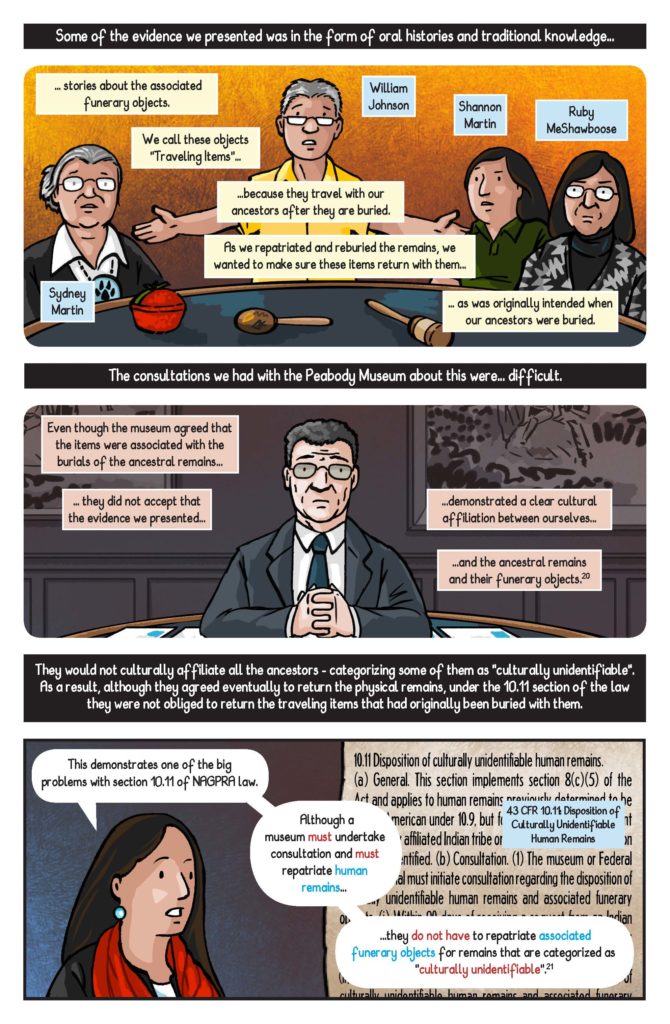Category: Uncategorized
Neil Gaiman, The Brooklyn Public Library, and Old Game Consoles

The person is Neil Gaiman. My favorite author going back almost a decade and a half, someone who wrote (and still writes) fiction that felt truer than life to me. He showed me the importance of stories, how they shape us and the world around us. He writes for both children and adults, so there was a feeling of him growing up with me (even though I was reading his books out of order of publication). I have always been a sucker for thematic cohesion, and his books had themes that appealed to me when I was young and continue to appeal to me today. Things like the importance of stories, finding truth when things seem dark, and the idea that even when things seem hopeless there is always something that can be done. Cleverness, compassion and luck seemed to be the three traits one needed to succeed in Gaiman’s world, and those were the traits I aspired to. When I knew little of him as a person and only knew him as an author, I still felt a connection, which proved to be a good instinct. I learned that Gaiman is an advocate for truth and the accessibility of information, he championed libraries in a way that resonated with me, a young woman who spent more time in a library than almost any other place. While I was reading a recent collection of his nonfiction writing, The View from the Cheap Seats, I realized just how much his writing had shaped my mindset and how much that meant to me. Even the way I write tends to be influenced by him, with many parenthetical asides (though one could cite Lewis’s influence on him becoming his influence on me for that) and a strong voice that may sometimes border on rambling being associated with him as a narrator, as well as being hallmarks of my own writing, though I have much less honed skill than Mr. Gaiman does. His use of language and clear love of words is what drew me to him all those years ago, and what keeps me coming back to him. To this day, if he releases a new book or even recommends one, it immediately goes to the top of my To Read Next list, and his books are among the first I recommend to people who are looking for something a little unusual.
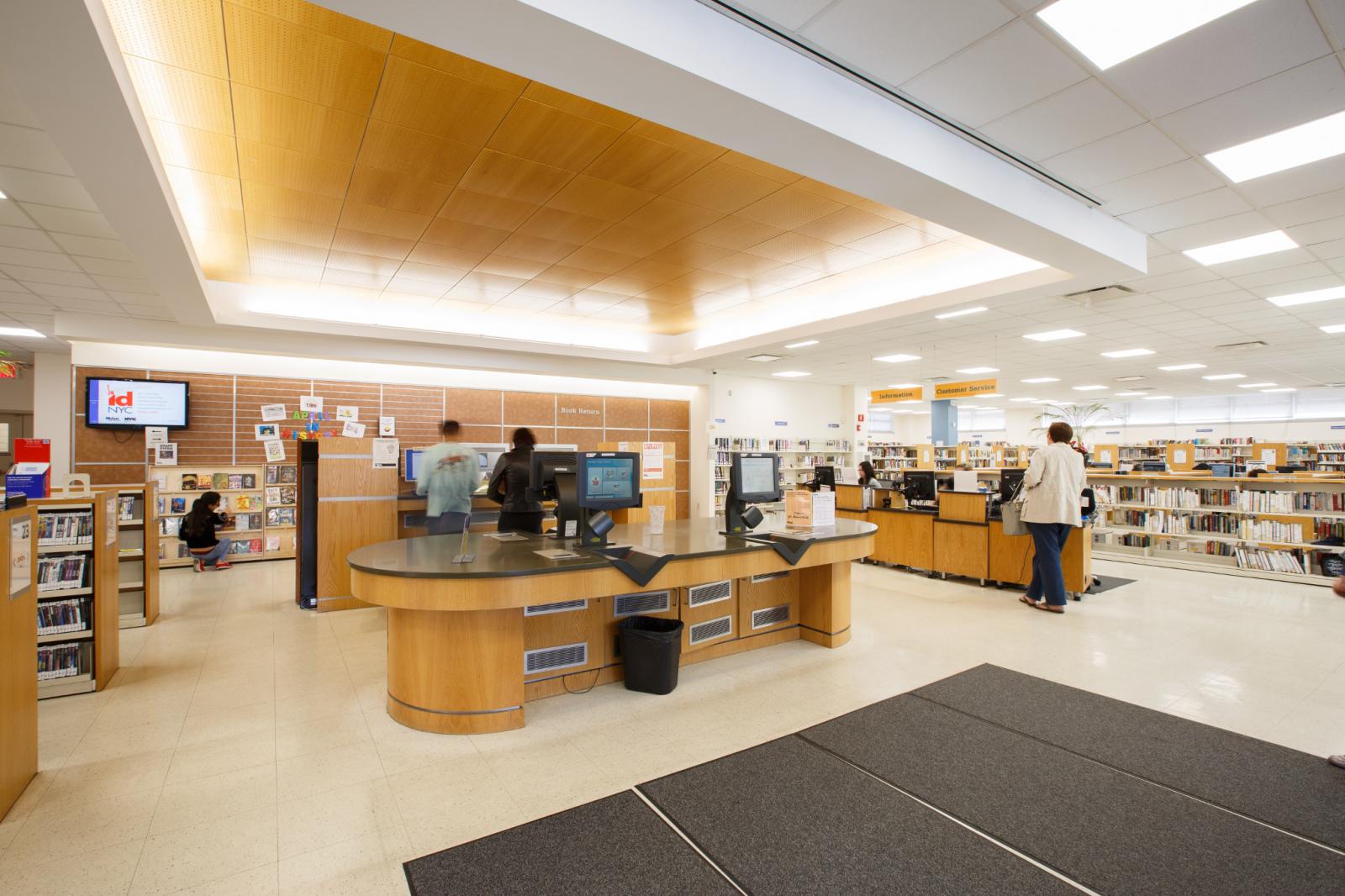
The place is always the Brooklyn Public library. Generally, it’s the King’s Highway branch but I’m not exclusive. I’m sure that it’s not a shock that someone whose goal is to be a librarian is choosing the library, but it was the place I grew into my own. I have been a part of the BPL system as a patron for the majority of my life, and living walking distance from a branch gave me much needed space in my angsty tween to teen years. I attended children’s shows there when I was very young, brought myself to poetry clubs and craft clubs when I was older, and on the days in between I stayed comfortably at a table between the YA and Graphic Novel section. I settled into a rhythm of arriving home, having a snack of some sort, and heading to the library until it closed every day after school from 7th-12th grade. Summers it was common for me to spend the whole day there several days in a row. Some of this was because we had no internet at my house until May of this year (2019), but even now, when I need to spend time working on homework and not getting distracted by my cats or chores that somehow get more appealing when I sit down to work on assignments, I pack up my backpack with my laptop and a pair of headphones and trek the three blocks to get some focus. It would be hard to overstate how much the Brooklyn Public Library shaped me growing up. When I had very little disposable income, I didn’t have to spend it on books, those were accessible to me for free (the benefit of going to the library almost every day is that it is very hard to end up with high late fees). I was able to experiment with the books I wanted to read without any financial investment, so there was no shame if I did not finish a book. This, I think, is the main strength of a library to help people become readers. There is no up front cost, there is no monetary risk or expectation, there are just stories here that want you to find them and people here who want to help you look. These long days spent wandering shelves, asking librarians questions (generally questions of what to read next) and learning how to share space for long periods of time with many people are what made me consider a career in libraries. It started as a desire just to want to be around books, but it became more than that. People refer to the library as a sacred space, but I disagree. It is the place where we are the most human, the most communal. The unique way that the library fosters both solitude (in allowing for a space where focused work to get done or self discovery to take place) and community (a shared space where everyone’s needs must be navigated) is what draws me to them now, and what inspires me to be a part of that space as a librarian.

My thing is a little more abstract, old game consoles. In my who, I talked about the importance of stories to me, and I found those stories not just in books but in video games as well. The stories in games are often well crafted and told beautifully with art, music, and interactive elements highlighting their plots, characters, and themes. I was lucky enough to either receive or save up to buy many consoles through my life, and I’ve held on to all of them and have worked hard to keep them in working condition. Why? Well, games are a quickly evolving medium. Console generations last about 7 years on average, and when a company shifts to a new console hundreds of games get left behind. If you get rid of your old console, all those games become unplayable unless the company decided to reboot or remaster them. This was what caused my first realization that conservation of art is not guaranteed. Games could be considered classics and yet still be left unplayable for the rest of time, and unlike other media like books or films, the vast majority of games would suffer this fate. Some people (I sometimes like to refer to them as unlicensed game archivists) created emulators and ways for the games to be made playable on computers so that they can be accessed by those who don’t have these old consoles, but those are often shut down by game companies who worry that these will cannibalize their profits. Until there is a better solution to all of this, I will just have to hold onto my old consoles (though even those are slowly becoming technologically obsolete due to a move to HD televisions). They are like small time machines or even tiny archives of their own, and those that own them are small scale archivists for themselves, deciding what games from the past they wanted to be able to pull out one day to play and refer to.
Event Attendance Blog Journal: Made in Africa Tech Conference- Dr. Rabina, Event Review
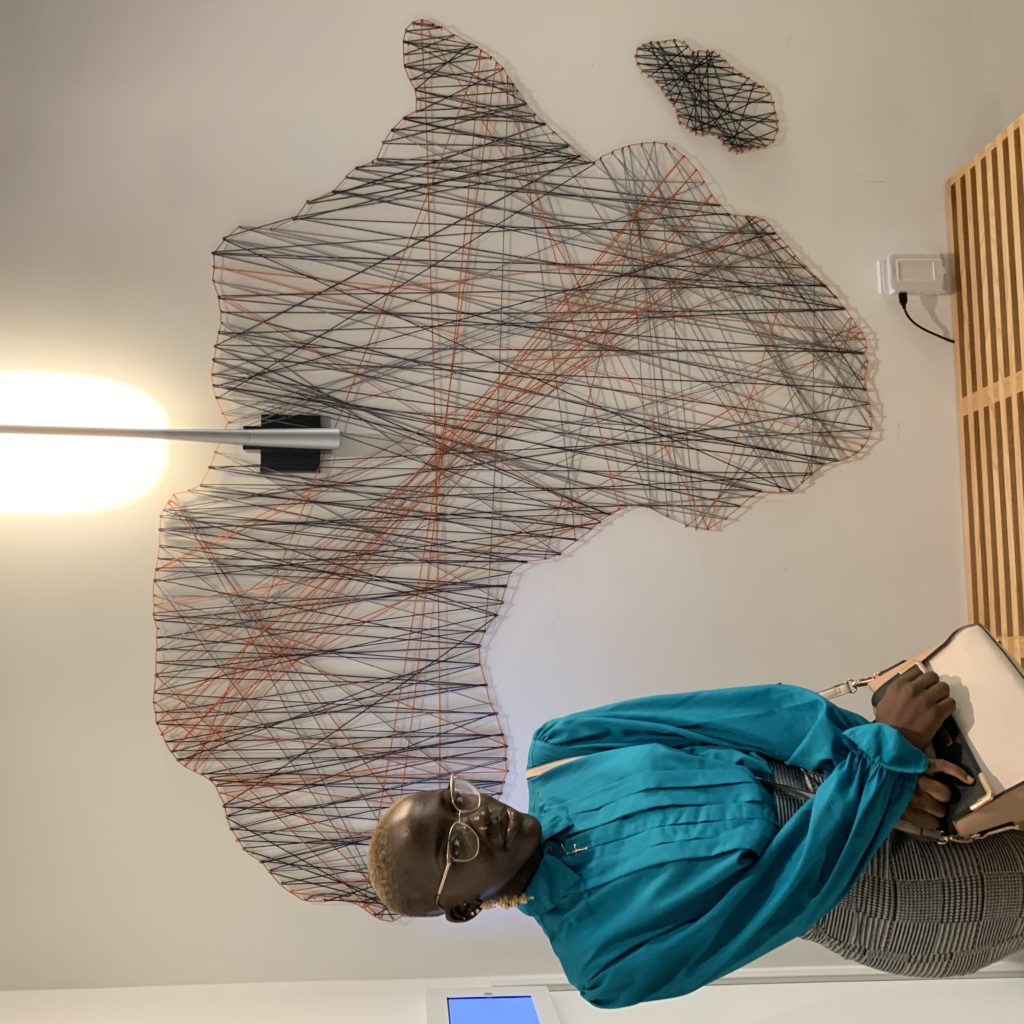
This past Friday on September 20th, 2019 I attended the Made in Africa Tech Conference which took place in Silver Springs, Maryland. Organized by Leslie Tita who’s background is in UX Design, he is also the founder of the Made in Africa Conference and I/O Spaces , where the event was held. Taking place from 9 a.m. to 7 p.m., attendees were able to hear and learn from industry leaders in the African community.
The conference began with keynote speaker Will Jawando, Montgomery County Council member. He gave spoke briefly on the immigrant’s population in Silver Springs, shining light on the African Community and their work along with discussing identity within the Black Community. Also coming from a Nigerian background, a powerful statement from Jawando that stood out to me is “We can be fully African and fully American, we need to normalize our combined culture.”
Following Jawando’s introduction, the panel discussions began with the topic African Fin Tech Temperature: Are Accelerators and Incubators Ready for Business?The speakers of this session were Chinedu Enekwe and Rebecca Enonchong. The session discussed the growth of Africa’s Fintech companies along how the owners of these companies are not seeing their own profit. There has been an increase of startups on the continent with the leading countries being South Africa, Nigeria, and Kenya. A major factor in the increase of startups is due to high investor confidence from foreign investors. Despite the positive results of an increase of fintech startups, the foreign investors are taking advantage of this business owners, hence why profits are not being seen.
The session that really caught my attention and that was relatable to my future career in the field of User Experience to is Perspectives on Reframing Patient Care and management via Tech Apps. The speakers wereMohamed Kamara, Tawani Anyangwe, and Dr. Nkobena. Kamara and Anyangwe both come from a computer science/software engineering background while Dr. Nkobena is a pharmacist. They discussed the outcomes of combining technology and healthcare, resulting in telemedicine and telehealth apps, how it can improve the healthcare system, and why Africa needs to utilize these methods more. Some of the positives discussed were managing chronic conditions, prescribing medication, reducing hospital readmissions, and overall lowering costs.
Through these healthcare applications patients can have a doctor available to them immediately despite location. Patients have the option of video calling, sharing images, or texting their physician. It is determined by preference and urgency. The applications are required to be HIPPA compliant in order for medical diagnosis and treatment to be offered. According to PC Magazine, with the increase of telehealth and telemedicine applications, it is creating a competitive marketplace resulting in lower health care costs. By reducing time to access and fuel consumption, along with increasing preventative care, these applications are transforming health care. Dr. Nkobena discussed the benefits of telehealth and telemedicine from the doctor’s perspective also. Due to E-Prescriptions, she is able to receive prescriptions electronically and fulfill prescription request in a much faster time. This is a prime example of enhancing quality patient care.
In my research of creating these kinds of applications, I came across Science Soft Professional Software Development also known as scnsoft.com. it as an IT consulting service that creates custom and platform-based solutions for Healthcare companies. They develop a range of patient applications such as patient engagement, telemedicine, medication, mental health, rehabilitation, and wellness. Their approach to creating to creating patient applications consist of many factors. First, they believe in creating in creating condition-based applications rather than one-size-fits-all. The application should address specific patient needs. Next, it should provide secure date exchange options meaning two-way communication. SCNSOFT emphasizes guaranteeing the integrity of protected health information. They also emphasize the importance of a user-friendly interface, stating that all their applications combine performance, style, and usability. With a focus on their end-users, creating easy to navigate applications that have practical value and appealing design is priority. Medical device integration is the fourth factor. Being able to integrate all types of medical tracking and medicine devices results in the better health outcomes and allows systematic care. Some examples are instant glucometers, heart rate monitors, and smart asthma inhalers. Last but not least, the final factor is support. ScienceSoft has a support team available at all times to assist with issues regarding the application.
Rebecca Enonchong was the closing keynote speaker and ultimately who I was most thrilled to hear speak. She is mentioned previously but I did not describe who or what she does because I wanted to discuss her last. She is a Cameroonian technology entrepreneur and the founder of AppsTech. She is also an investor and part owner of I/O Spaces. Her donations to the field of technology in Africa is what she is best known for. Enonchong spoke on the development of her business AppsTech which provides enterprise applications solutions. Her company turned twenty years old this year, originally being based in Marlyland. It has now expanded to having several offices in different locations across the United States, Europe, and Africa, including her home country of Cameroon along with consumers in over forty countries. She also discussed her non-profit The Africa Technology Forum which is dedicated to helping startups in Africa.
This conference opened my eyes so much to the impact I want to leave in the field of technology, especially in regards to Africa. The creators of this conference being from Cameroon inspired me tremendously because I am also Cameroonian. I learned an extreme amount of beginning a startup and creating applications that are usable not only here in the United States but also in Africa. It was a reminder that my vision is bigger than myself. My future career in the field of User Experience is also for the betterment of my people. From the organizer of the event, Leslie Tita to Dr. Nkobena and Rebecca Enonchong, and many others mentioned and not mentioned, I was inspired to not forget my roots once I reach my destination.
Duffy, J., Duffy, J., & Duffy, J. (2015, February 11). 10 Apps That Are Changing Healthcare. Retrieved from https://www.pcmag.com/article/331934/10-apps-that-are-changing-healthcare
Home. (n.d.). Retrieved from https://www.scnsoft.com/healthcare/mobile/patient-apps
Person, place, thing: When old meets new
Thing: The Evening World Newspaper
Last weekend my family were making repairs to our shed in the backyard. As they took down some of the old wood from the wall, they discovered a piece of an old newspaper. The paper was wet from the condensation in wall and they placed it on a flat surface covered by a black plastic bag to give it time to dry, and protect it from light. Two days passed. I was afraid to damage the paper but, finally I gained the courage to remove the bag to try to inspect what was underneath. It was a newspaper called the Evening World dated Wednesday, June 12, 1907! I was shocked and intrigued. The newspaper was so fragile. I practically came apart in hands, but I managed to get some pictures.
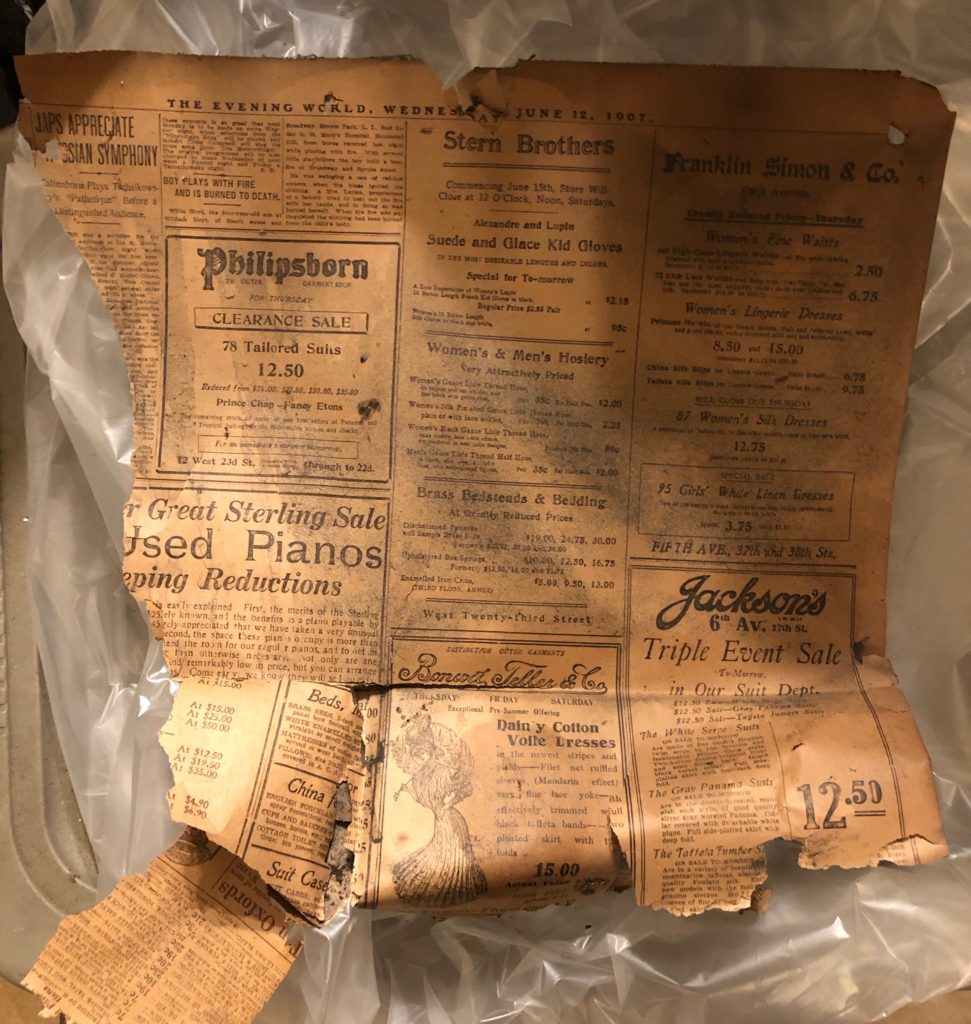
It was amazing to see the types of advertisements for lawyers, dressmakers, medicines, and tinctures. I marveled at the low prices. The biggest story on one of the pages was about roller skaters. It was an article talking about what the New York City Streets would come to if the these “crazed” young people were allowed to take over with roller skates. I mused to myself wondering what the people of that time would think now if the saw all the young folks today on skateboards! I’ve always had an avid curiosity about the past. I’ve read countless stories about the lives of people from different eras. And I was excited to have an actual 112-year-old newspaper in my hands.
Person: Michele Valerie Cloonan
I recently read an article by Michele Valerie Cloonan entitled “W(h)ither Preservation?” Cloonan is a Professor and Dean Emerita at Simmons College. She is also the editor of Preservation, Digital Technology and Culture.
In her article she takes issue with the disappearance of preservation departments in lieu of digital initiatives at various institutions, and she puts forth the question: “Whither we (preservationists) should be going rather than letting these programs die” (Cloonan, 2001). As we move further into the digital era there have been many developments in technology that have allowed new methods of preservation to emerge. But with the new technology there are new concerns. In libraries there are concerns about whether an object should be retained or just the digitized information (Cloonan, 2001). Due to the nature of digitized data, there are also questions about the altering of documents that have been reformatted, as well as, questions with regard to security. Ensuring access points for all this digital information is also an issue that causes some trepidation (Cloonan, 2001).
Place: Museum of the City Of New York
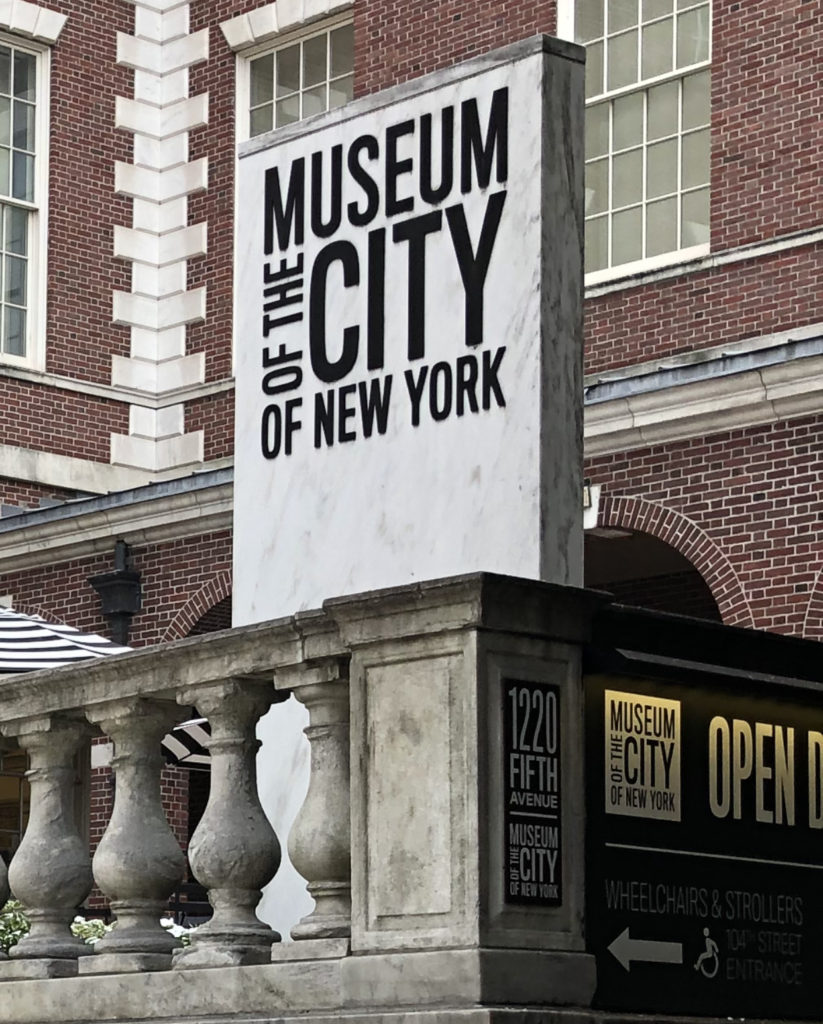
With all these concepts floating around in my head along with my fascinating newspaper discovery, I decided to take a trip to the Museum of the City of New York. I wasn’t sure what I was looking for, but when I arrived, I was pleasantly surprised. I noticed that there was an amazing array of Exhibits that seemed to combine both the tractional museum model of artifact and description combined with new media. There were two exhibits in particular that had lasting effect on me. New York at its Core World City, and the Voice of the Village Exhibit.
NY City at its Core consisted of three presentations: Port City 1609-1898, World City 1898-2012, and Future Lab. The Port city Exhibit was particularly interesting. It was a small display in a darkened room with a series of various interactive displays and digitized maps throughout. In particular there was a virtual display of Mulberry Street. The interactive component allowed the viewer to investigate the photo in great detail. The display allowed you to zoom in on the digitized photo to highlight sections, as well as, find out additional details. The convergence of media to create such a display added to the user experience, and gave what would have been a simple photograph new life.
The Voice of the Village Exhibit was a more traditional exhibit highlighting photographs and print chronicling historic moments in New York City’s history. In light of my recent find, it was poignant to see how the impact of a newspaper could affect how we contextualize events that contribute to how we think about history. The use of the actual newspaper as part of the exhibit also spoke to the importance of using both new technology alongside physical artifacts.

Overall my visit to the Museum of the City of New York was enlightening. I chose this museum specifically to get a better sense of what New York was like during the period the, June 12, 1907, Evening World Newspaper issue was published. It helped me to gain a deeper understanding of the environment, and the factors that lead to what was considered the news for the day. It had been a while since I visited a museum, and I was captivated by the new methods used in the presentation of historical content. These exhibits were a vibrant integration of both the established methods of cultural preservation with leading edge technologies. I found them to be engaging and thought provoking. Cloonan writes: “…we must confront the fact that the experience of using digital documents will be different with each new generation of use” (Cloonan, 2001). While this is true, I believe it is part of the process. Each generation should and will project their own set of values and interpretations onto preserved history to give it broader context. We see this trend happening now in our quest to restructure our own institutions in an effort to become more transparent and inclusive. Furthermore, the digitization of documents will give an extended life to antiquities when they are no longer physically present. Hopefully, with continued interdisciplinary discourse we will find ways to ensure greater security and continued access to these treasures that will engage the public.
In closing, sadly it was too late to save the newspaper we found in the wall. In just a short time of being exposed to the elements it fell apart, but at least (as I stated above) I managed to get some good pictures. I was also able to find a digitized copy of the Evening World through the Library of Congress Website. Interestingly two of the pages I have are not present in the digitized copy. To View the digitized copy click here.
Citations:
Cloonan, M. V. (2001). W(H)ITHER Preservation? The Library Quarterly: Information, Community, Policy, 71(2), 231-242. Retrieved from http://www.jstor.org.ezproxy.pratt.edu:2048/stable/4309507
Library of Congress, June, 12, 1907, Evening World, [Newspaper] Chronicling America: Historic Newspapers, Library of Congress Retrieved from https://chroniclingamerica.loc.gov/lccn/sn83030193/1907-06-12/ed-1/
McDarrah, F.W. (1926-2007), Village Voice Covers, May 23, 1963, Newsprint, Collection of the Estate of Fred W. McDarrah
Person, Place, and Thing: An Architect, an Airport, and a Tesla
Person: Richard Saul Wurman

Although formally trained in architecture, Richad Saul Wurman has been credited with the term “information architecture” as he applied his architectural background to help shape the field.
Wurman initially never thought of himself as an information architect or even thought that his ideas would contribute significantly to the field. Instead, he simply saw a problem with the increasing amount of information that was available and wanted to find a way to organize it. The following excerpt from Resmini and Rosati’s (2011) article captures the parallels he saw between architecture and information architecture:
Wurman’s maintained that as much as architects are expected to create structure and order in the world through planning and building, information architects were expected to draw lines and derive some kind of order in dataspace, their primary task being to make this information simpler, more direct, and ultimately more comprehensible.
He addresses the problem of increasing information by proposing design solutions. Because of his background and the angle that he approached information architecture, much of what Wurman presented mainly concerns the visual aspects of presenting large amounts of information. Nevertheless, his contributions are significant as his perspective has changed the way information professionals view, manage, and present information.
Indeed, Wurman’s most significant contribution to the information profession is that he introduced principles of information design and how all aspects of the field can implement design solutions. As Wurman was concerned with “deriving some kind of order in dataspace,” the aesthetics and visual impact of information is just as important as, say, a database itself. The information within it needs to be easily accessible, understandable and effective. Thus, many information professionals now also consider this approach when designing new systems and databases, or when presenting any form of information. As the amount of available information continues to increase, Wurman’s approach to information architecture seems very much necessary to create structure, order, and comprehension.
Place: Changi Airport

The Changi Airport in Singapore is consistently ranked as one of the best airports in the world. With world-class dining, shopping, gardens, and art installations, it’s an attraction in it of itself rather than a mere layover. The amenities and layout of the airport truly make it an exceptional experience and is an example of what happens when user-centered research and design is utilized in a public space.
In designing the airport, the placement of chairs was an important factor. Kenneth Ho, Senior Manager of Airport Facilities, explains that in providing a comfortable and luxurious experience, “single seaters spaced far apart are available for travellers seeking solitude, while clusters of comfortable lounge seats are designed for bigger groups like families” (Changi Journeys, 2016). “Snooze chairs” are also provided with outlets so flyers can charge their devices while resting comfortably (Changi Journeys, 2016).
In addition to providing comfortable seating, the airport also recognized the importance of its layout and how it can influence human behavior. For example, high-traffic areas have no seats to ensure a clear passageway while chairs in public areas “have arm rests to deter people from lying across it” (Changi Journeys, 2016). It is often the little things, like arm rests on chairs, that most people often overlook but can make a big difference.
This idea of strategically placing and designing chairs reminded me of Don Norman’s (1988) discussion of doors in his book, The Design of Everyday Things. A well-designed door is one that you automatically know how to use. A poorly designed door is one where you end up trying to push it open when you should be pulling it open. Ultimately, good design is something that you don’t notice because you don’t need instructions telling you how to conduct something because it has been designed with the user in mind.
Just as user-centered design can help with the flow of airport foot traffic, it can also help in crafting a better information experience. The application of user-centered design may be even more imperative now as information is rapidly becoming digitized and people now have numerous options to consume it. While doors and airports may seem completely unrelated to the field of information, the goal remains the same, which is to provide a better and improved experience for the user.
Thing: Tesla Vehicles

Some say Tesla has revived and revolutionized the electric vehicle industry. Surely, the vehicles arrived at a prime time when climate change is a pressing topic for politicians and more renewable energy options are available, but environmental consciousness is not the only reason for crediting Telsa with revolutionizing an industry.
Sit down in a Tesla and the first thing you notice is the absence of buttons, knobs, dials, and other gadgets that are usually associated with a vehicle’s dashboard. Instead, a large touchscreen sits in the middle, where such buttons and dials would have been. This touchscreen essentially controls everything in the car, from air conditioning to music. What’s even more noticeable about this touchscreen is that it can be customizable. You can input your name and then create settings to your preference so whenever you get in the car and tap on your name, the car is catered towards your experience. This idea of creating a catered experience for the user is closely related to Heidi Cooley’s discussion of the iPhone in Finding Augusta: Habits of Mobility and Governance in the Digital Era. In referring to Lev Manovich’s note about “playing the iPhone,” Cooley states that this marks a shift from “the principally utilitarian functionality attributable to jog knobs, buttons, and keys that defined earlier mobile devices” (Cooley, 2014, p. 32) What Tesla did for electric vehicles is similar to what Apple did for smartphones in that both companies rejected traditional, or “utilitarian,” views of what their products should look like and instead reimagined how it could be.
By replacing the traditional dashboard with a touchscreen, Tesla achieves a more fluid interaction between driver and vehicle. Cooley even goes on to state how “this idea of human-device interaction as skin-on-skin contact discloses something profound about ourselves as well as our devices” (Cooley, 2014, p. 36). Perhaps this “skin-on-skin contact” that is evident in both the iPhone and now a Tesla is necessary for facilitating such a unique user experience. Ultimately, Tesla revolutionized the electric vehicle industry by reimagining the user experience of the automobile. There has not been a car like a Tesla before and it certainly is the first luxury electric vehicle of its kind.
References:
Cooley, H. R. (2014). Finding augusta: Habits of mobility and governance in the digital era. Hanover: Dartmouth College Press.
Designing the changi experience. (2016). Changi Journeys. Retrieved from http://www.changiairport.com/corporate/media-centre/resources/publication/issue-2/designing-the-changi-experience.html
Resmini, A. & Rosati, L. (2012). A brief history of information architecture. Journal of Information Architecture. Vol. 3, No. 2. Retrieved from http://journalofia.org/volume3/issue2/03-resmini/
Protected: Person, Place, Thing: A Librarian, a Library, and a Radio Tower?
Event Review: Braiding Strands of Wellbeing: Reclaiming, Healing, and Sending Knowledge into the Future
In her talk, Braiding Strands of Wellbeing: Reclaiming, Healing, and Sending Knowledge into the Future, Dr. Sonya Atalay discussed anthropologists and archaeologists can and incorporate the local and indigenous populations’ cultural practices of sharing and preserving knowledge into their studies of these cultures. An anthropologist and Ojibwe (the Native American tribe also known as the Chippewa) keeper of knowledge, Dr. Atalay has conducted anthropology and archaeology research within indigenous populations in North America as well as the Middle East. Her work, including her books Community-Based Archaeology: Research With, By, and for Indigenous and Local Communities and Transforming Archaeology: Activist Practices and Prospects, has been focused on the development and implementation of participatory research, seeking to decolonize the language and practices used by non-indigenous researchers as well as justice for communities through the collection of indigenous artifacts. Dr. Atalay is currently working on her book, Braiding Knowledge, an ethnographic review of these projects and other engaged scholarship of indigenous communities to how collaborative knowledge production are transforming research practices and outcomes. Many of her concepts are similar to practices found in the Ethics of Fieldwork by the Program for Ethnographic Research & Community Studies, expanded and adapted to the fields of Anthropology and Archaeology.
The main example used in her talk was the ezhibiigaadek asin, which translates to “the place where knowledge is written on stone”, a Saginaw Chippewa heritage site archaeologists refer to as the Sanilac Petroglyphs.The carvings on the rock face represent history of the tribe as well as instruction on how to send its knowledge into the future. A sacred site, with important physical and cultural links to the surrounding area, cultural practices involve water art ceremonies where tribal elders bring river water to wet the carvings and share the histories and practices represented. The researchers working on the site, to protect the site for their own purposes, had covered the rock face with a pavilion and installed a fence to prevent erosion and vandalism of the carvings. Gated and only available to the public upon request of a scheduled visit the indigenous community could not access the site or conduct the water art ceremonies.
A place of knowledge for both tribe members and anthropologists, the difference in approach to accessibility and use of the physical site indicates the divide in perspective each group holds about the information the site contains and how to it should be studied. Not only did researchers not take into account the indigenous people’s desires for how the site is utilized but also the outcome and application of the research. A source of contention was the misinterpretation of one petroglyph archaeologists dubbed the hunter. The carving actually depicts shkabewis, a spiritual teacher sending information and knowledge into the future. Not only had the researchers misinterpreted its meaning, fitting the colonial narrative of Native Americans as hunters rather than purveyors of knowledge and information, the University of Michigan had copyrighted the image of the carving and used it in branding. they as well as the the physical site, the information and knowledge it contains
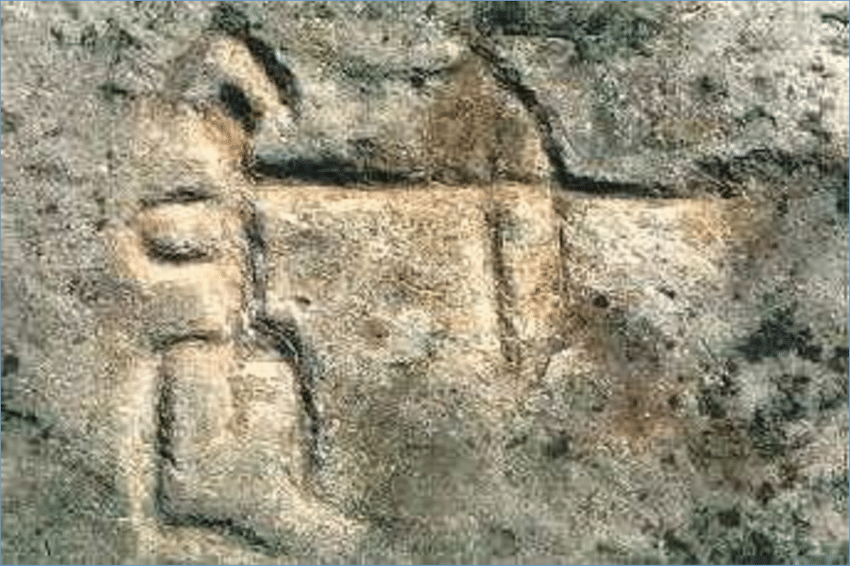
When the researchers began consulting the Ojibwe leaders, it resulted in a shift in practices, results and use of their work. By addressing some of the concerns PERC in the such as establishing a rapport with the participating group, learning indigenous knowledge needs and desires of application of the research and the representing the participants in a recognizable and respectful way. The Saginaw Chippewa gained more consistent access to the ezhibiigaadek asin as well as influence over the conduction and results of the fieldwork. The archaeologists gained a more accurate representation of the petroglyphs and people that created them.
Dr. Atalay presented the ethnographic comic “Journeys to Complete the Work: Stories about Repatriations and Changing the Way We Bring Native American Ancestors Home (NAGPRA Comics: A Graphic Narrative)” she co-authored with John G. Swogger, and Jen Shannon, in collaboration with Shannon Martin and William Johnson of the Ziibiwing Center of Anishinabe Culture & Lifeways, and Tribal elders Sydney Martin & George Martin. The comic details the effort of anthropologists and tribal leaders to have the remains of Native American peoples, held by several museums, returned to their ancestors for proper burial on the basis of the Native American Graves Protection and Reparations Act. This comic, along with others Dr. Atalay has produced on similar topics, is a novel way for Ethnographers to share their research practices and results with the populations they study and the general public.
Dr. Atalay’s talk was an enlightening look at how ethical fieldwork in ethnographic studies, including the concerns outlined in the PERC document, can be practically applied to a variety of fields of study.
References:
PERCS: The Program for Ethnographic Research & Community Studies, The Ethics of Fieldwork
Atalay, S., Shannon, J., Swogger, J., (2017) Journeys to Complete the Work: Stories about Repatriations and Changing the Way We Bring Native American Ancestors Home (NAGPRA Comics: A Graphic Narrative)
Observation at the Copper Hewitt Smithsonian Design Museum

Copper Hewitt museum is a constantly innovative place which always gives me surprise. During this visit, the new exhibition content has brought me new information experience. The first step after entering the museum is to purchase admission tickets. The museum staff gave me an interactive pen and asked me if I have been here before. Since this is my second visit, I had understood the functionality of the pen and felt excited and looked forward to the actual use of it.
The current exhibitions is inclusive of Nature by Design, Rebeca Méndez Selects, Moustiers ceramics, Iridescence, Immersion Room, Models & Prototypes Gallery and Scholten & Baijings in the Process lab (“Cooper Hewitt, Smithsonian Design Museum”). The innovative exhibits in museum brings people brand-new feelings in all the aspects of sense, hearing and touch.
The installation in Process lab invites visitors to explore the design process of contemporary industrial design studios by themselves. The lab shows some industrial crafts and a number of interesting details about the making process of tableware, furniture, and textiles. Some objects from collection are available for touch and two interactive tables are offered for color experiment.

Immersion Room is a creative space where visitors can draw their own wallpaper designs and experience the full-scale projection of pattern on the walls around them. At the same time, visitors can select wallpapers from museum’s extraordinary collection and see them projected on the walls, accompanied by audio clips about the information of that particular design or designer. Multiple types of information give visitors immersive experience, which helps them find inspiration and learn to create.

There is a new project at the second floor “How was your commute to the museum?” which analyzing the commuting process of visitors. Visitor can pick a small red or green ball and put it into one of the transparent buckets which corresponding to a certain type of commuting. The green ball means “good” experience while the red one means “not so good”. The commuting types including pedestrian, bicycle, motorized vehicle, bus and subway. These soft color balls arouse interest of visitors to participate the project, which provides statistical data for future strategies on enhancing museum experience.

Copper Hewitt has made some intriguing digital innovations in the field of interaction, among which interactive Pen and touchscreen table are the two major innovative features of museum. Both interactive pen and touchscreen table give visitors the new experience compared with traditional museum experience.
Interactive pen gives visitors the opportunities to immerse in the process of seeing and feeling exhibits instead of taking pictures busily or using traditional museum App. By aligning and pressing the flat end of the Pen to any object labels, visitors can collect and save objects from around the galleries. Then all the saved exhibits information will be accessible online for future read. Meanwhile, the pen is also used to explore and manipulate the objects that visitors have collected on the touchscreen table. Copper Hewitt converted the pen to a piece of consumer hardware by cooperating with an international team, as stated on the museum site, “Like so many of the objects in the museum’s galleries, it is the product of a collaborative, international industrial design process, exemplifying how designers solve real-world problems.”
According to the introduction of interactive table on museum website, touchscreen tables uses projected capacitive touch technology, offering the same resolution as tablets and smart phones, which enables visitors clearly observe the details of exhibits and get inspiration. This visitor technology emphasized the play experience and displays the specificities of a design museum. Interactive table is not only a “collection browser”, but also a “play designer” that offers various materials, modes and object scenes for drawing three-dimensional model types by visitors themselves.
Copper Hewitt Museum’s innovation on digital experience shows that it attaches great importance to the interactive experience between visitors and exhibits. By building interactive digital entity space, it transforms the traditional one-way display platform into an interactive space for public participation. More broadly, it reflects a digital transformation trend of cultural institutions. With the rapid development of information technology, especially the coming of big data era, our social lifestyle is facing the situation of being changed profoundly by IT, and so does people’s cultural life. As the closest cultural contact with the public, cultural institutions can no longer meet people’s requirements change and diversity according to existing service mode. Therefore, many cultural institutions around the world have been exploring and practicing digital construction in recent years, such as innovating institute website and mobile app or creating virtual experience projects.
Digital and emerging media is helping cultural institutions successfully meet their missions by various digital strategies. According to Xingya Wang, being more accessible, engaging content and generating revenue are what museums are focusing on based on their strategies, and digital innovations give museums these possibilities.
In order to be more accessible, museums are providing audience with more open access to collections and making museums websites more accessible. Take National Portrait Gallery as an example. In recent years, National Portrait Gallery is not only extending the range and methods of viewing digital images of their collections and addressing the importance of open and sharable sources, but also prioritizes investment in redesign of its website to create seamless user experience. To enrich the content, there are many museums have embraced digital media as a creative method. Among them the Metropolitan Museum of Art is one standout. The Met is regarded as a potent, full-fledged media company because its digital achievement (Baker, 2015). Begin from 2011, the Met has been working closely with industrial organizations to develop apps, 3D print interactive objects and virtual reality experience for the museum. The Met also built a 70-person digital media team in order to formulate and implement effective content strategies in media-saturated landscape. Experimental initiatives including content creation and content distribution. Besides, using digital methods to generate revenue and funding of museum is another trend. Digital activities or products including digital funding model, better UX design, online courses, paid onsite multimedia tour, self-serving ticketing and so on.
Meanwhile, many cultural institutions are also involved in the field of digital technology education for public. For example, Tate, an institution that houses the United Kingdom’s national collection of British art in a network of four art museums (“Tate”), has built a Digital Learning Studio to increase participation and attraction. As a multi-use space for making and learning about digital technology, the studio offers a wide range of learning programs including courses, workshops and development projects.
The digital transformation of cultural institutions is a digital practice which redefines the interaction between public and institutions. According to Dalbello, “Public conversation is at the core of heritage practices involving artifacts and their digital representations”. In this sense, through digital transformation, cultural institutions are extending their role to become participates in a broader discourse with the public.
Reference:
“Cooper Hewitt, Smithsonian Design Museum”. Cooper Hewitt Smithsonian Design Museum, 2019, https://www.cooperhewitt.org/.
“Tate”. En.Wikipedia.Org, 2019, https://en.wikipedia.org/wiki/Tate.
Wang, Xingya. “Review Of Different Museum Digital Strategies”. Museums And Digital Culture – Pratt Institute, 2018, https://museumsdigitalculture.prattsi.org/review-of-different-museum-digital-strategies-6ec009d2f80b.
Baker, Dillon. “Museums, The Next Media Companies: Why The Met Built A 70-Person Media Team”. Contently, 2015, https://contently.com/2015/05/12/museums-the-next-media-companies/.
Dalbello, Marija. (2009). “Digital Cultural Heritage: Concepts, Projects, and Emerging Constructions of Heritage.” Proceedings of the Libraries in the Digital Age (LIDA) conference, 25-30 May, 2009.
Event report: The World Blockchain Forum (WBF)
The events are held in New York City almost every day. I’m glad to have a chance study here. Through the activities I attended, the most impressive event is the World Blockchain Forum.
A brief introduction of WBF: The World Blockchain Forum (WBF) was incorporated in New York in 2017. Located at Wall Street New York City, WBF focuses on the frontier of global blockchain technology, which is committed to building the “Davos Forum” in the field of informational technology. WBF strives to establish a platform to establish an interconnected and thriving social community to share the cutting edge resources of blockchain technology.

The event was held in the Hilton Hotel in 2018. The conference hall had a huge space to hold hundreds of people with green brand everywhere. STO and Stable currency was the main topic of this event. Unfortunately, I just heard the speech about the introduction part and the conversation with Jeffery Wernick who was the earlier Bitcoin investor and VC of Uber and Airbnb. Behind the hall, there is a room for the exhibition for the application of blockchain technology in different fields. Most of them are Game or Financial Companies.
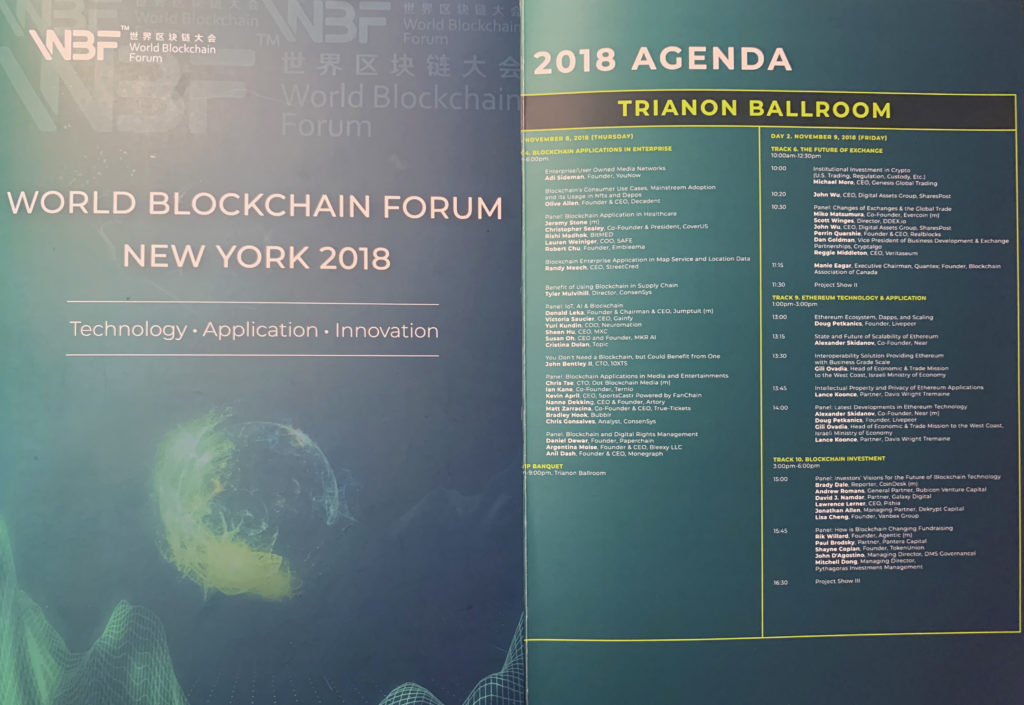
First, they start to talk about the founder of blockchain technology, Satoshi Nakamoto. He published the paper called Bitcoin: A Peer-to-Peer Electronic Cash System. However, no one knows who he is. People only know he is Japanese American. On April 20th, 2019, one bitcoin equals 5,317.67 $. Even though people start to doubt its value, they still trying to buy some bitcoins into their pockets. Actually, everyone hopes the bitcoin can maintain its value since investors have invested a bunch of money. Bitcoin’s price isn’t stable. I guess it’s one of the reasons to sell a Stable currency to poor money. For now, the most successful winners in blockchain are those people who brought the bitcoins at the very first time with incredibly low price. However, this will mislead people’s general understanding of blockchain technology, people may think that blockchain is only about trading bitcoins which creates a bias of this field.
From the basic definition of blockchain, Michael Crosby explained that, a blockchain is essentially a distributed database of records, or public ledger of all transactions or digital events that have been executed and shared among participating parties. Each transaction in the public ledger is verified by the consensus of a majority of the participants in the system. Once entered, information can never be erased. The blockchain contains a certain and verifiable record of every single transaction ever made. Through this view, the most obvious difference between blockchain technology and the conventional network is that blockchain is built by the decentralized system while the old network is controlled by the central machine. This difference gives the user a transparent database in blockchain technology. Once a block is built, the records in it can’t be modified. Plus, the blockchain serves a permanent record of all kinds of information on a blockchain network. It’s a revolutionary technology challenges the old network that database can be decentralized from the centralized server.
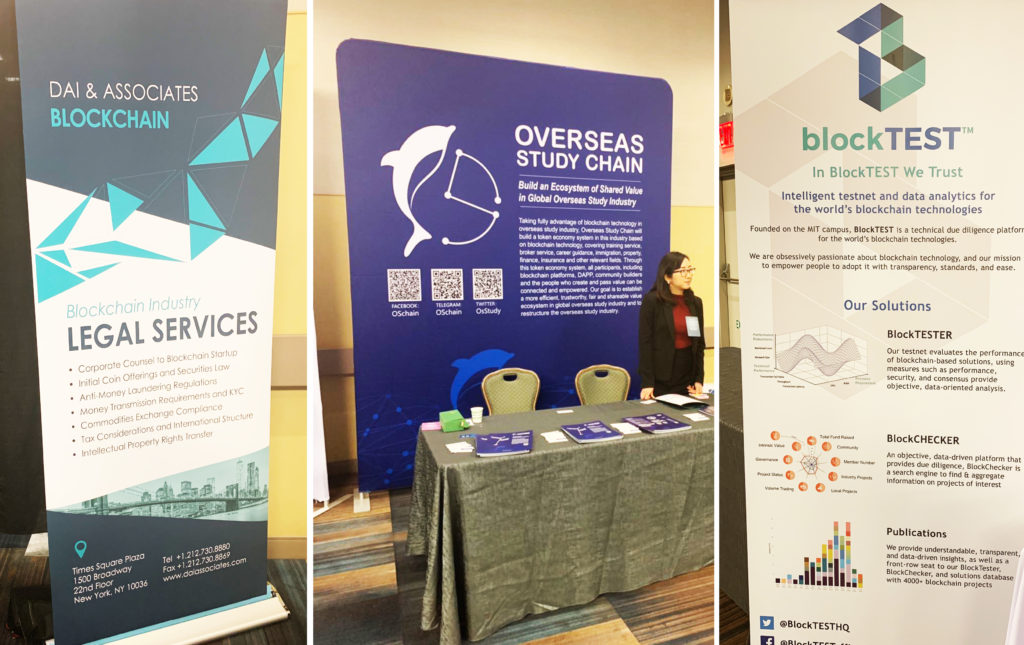
The blockchain technology has a huge potential value for many kinds of fields. It can be used for the banking system, healthcare, government, etc. As David F. Bailey said it’s hard to find an industry that can’t benefit from improved transparency, seamless execution of tasks and distribution of trust around the planet. People don’t know where blockchain technology finally triggers out but they still have faith in it. According to Jeffrey Wernick, the application in the blockchain that’s driving blockchain with the solution might not actually be blockchain but might be some of the derivatives that people who are trying to be to build decentralized scalable platforms that might not end up being on the blockchain. Therefore, people may not only use blockchain to trade bitcoins but also learn the way that blockchain deals with the database system which could provide a more transparent, more decentralized channel that may influence people’s living behavior. Take trading as an example, people can easily build trust by exchanging blockchain because it can’t be revised.
Nowadays, people from different fields try to manipulate blockchain technology to develop some creative way to solve a practical problem. Michael Painter, a senior program officer at the Robert Wood Johnson Foundation, pointed out health information infrastructure challenges keep us from solving our major healthcare problems. For instance, the lack of a useful, safe health data infrastructure dramatically inhibits our ability to harness new powerful technology, like artificial intelligence. Blockchain technology was just emerging when JASON tackled these health information questions, so it could not assess its promise or pitfalls. Blockchain technology, nevertheless, could arguably offer novel ways to get us closer to that elusive health care infrastructure-like helping with information exchange, privacy protection, and control. He was unsatisfied with the old information system because doctors can’t get the valid data to finish the healthcare development including artificial intelligence. What blockchain technology can provide is a block of solid useful data with trusted privacy system that solve their worries. Moreover, blockchain technology can also give contribute to complete global payment. For years, making global payments has been challenging for both businesses and individuals since bank fees associated with international money transfers continue to increase. In this sense, Rachel Wolfson, Blockchain technology and cryptocurrency journalist, points out that the application of blockchain technology is impressive for solving the main challenges facing international payments, McCaleb also has plans to make the Stellar Network to make a progress on that. If people from all over the world can make a deal with bitcoin, the world trade system will be more efficient and transparent.
Through this event, I recognized that blockchain technology draws big attention from society, not only because bitcoins become more and more expensive but also because blockchain technology has huge potential in many kinds of fields, such as financial service, healthcare, etc. I have faith that blockchain technology can make more progress in the future.
Work Cited
“World Blockchain Forum New York 2018 – the Premiere Blockchain Summit.” New York – World Blockchain Forum, newyork.keynote.ae/.
Michael Crosby, Technology: Beyond Bitcoin, AIR Issue No.2, June 2016
David F. Bailey, President, BTG Inc, Blockchain 2.0.
Michael Painter, JD, MD, is a senior program officer at the Robert Wood Johnson Foundation. Blockchain technology in healthcare: perfect answer or a new source of questions? Distributed, 03.
Rachel Wolfson, (Blockchain technology and cryptocurrency journalist), How the Stellar Network is reshaping the global payments industry.
Observation: Cooper Hewitt
Cooper Hewitt, Smithsonian Design Museum is a design museum located in the Upper East Side’s Museum Mile in Manhattan. It is one of nineteen museums that fall under the wing of the Smithsonian Institution and is one of three Smithsonian facilities located in New York City. I have been there twice. The first time was a field trip with professor Nada. It was a pretty impressive experience, different than visiting other museums. I didn’t see many traditional paintings but the contemporary design works. According to the introduction of Wiki, it is the only museum in the United States devoted to historical and contemporary design. Its collections and exhibitions explore approximately 240 years of design aesthetic and creativity. The second time I visited there was to finish the observation assignment so that I intentionally noticed more details.
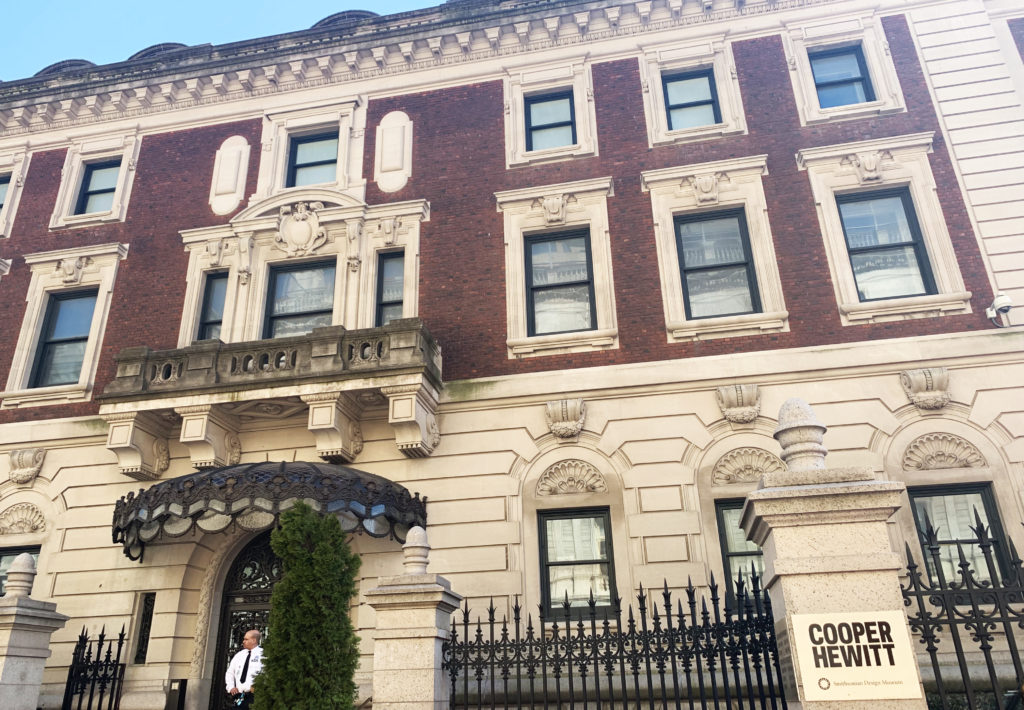
This museum has a perfect location in New York, near the central park. I remembered clearly it was a sunny day. Trees, flowers, people, river, all the things are so wonderful around this museum. However, it’s hard for me to recognize it’s a contemporary design museum because of its classical architecture style. I thought it might be a traditional museum as others in Europe. No matter the colors or decorate details of this building, it’s really hard for me to associate Cooper Hewitt with contemporary design.
I love this museum. The exhibitions include many masterpieces. The visiting experience is so comfortable because of the digital pen that visitors can use it to create their personal digital archive through the picture code. After they back home, they can see the interesting design works they picked up on the official website by entering the unique code on the tickets. It’s really a good way of sharing the database through the network. On the other side, it can be defined as a good transformation design. People feel more relaxed when they walking in the museum instead of taking pictures by smartphone all the time. To be more specific, the digital archive is a record of human history. In a similar way, the design is all about human requirements. In order to stay objective in the digital archive, scholars come up with an idea called archival studies thinking, a comprehensive understanding of records. I can see it’s a great record arrangement in Cooper Hewitt. It divides the exhibition into several parts; the first floor is Tablescapes and Process Lab; the second floor is Nature by design, Iridescence and Immersion Room. This arrangement leads the visitor to understand design comprehensively. According to Caswell, value is another core archival studies concept and it doesn’t mean archivists have to keep everything. When choosing an archive, archive users have to make decisions to choose the relevant important records (6). This decision is also connected with the structure of power in special events or society. For example, the artworks visitors choose to record by the pen are not only because the works are beautiful, but only because I notice the work are made by the famous designer who made a big influence on society, like Paul Rand.
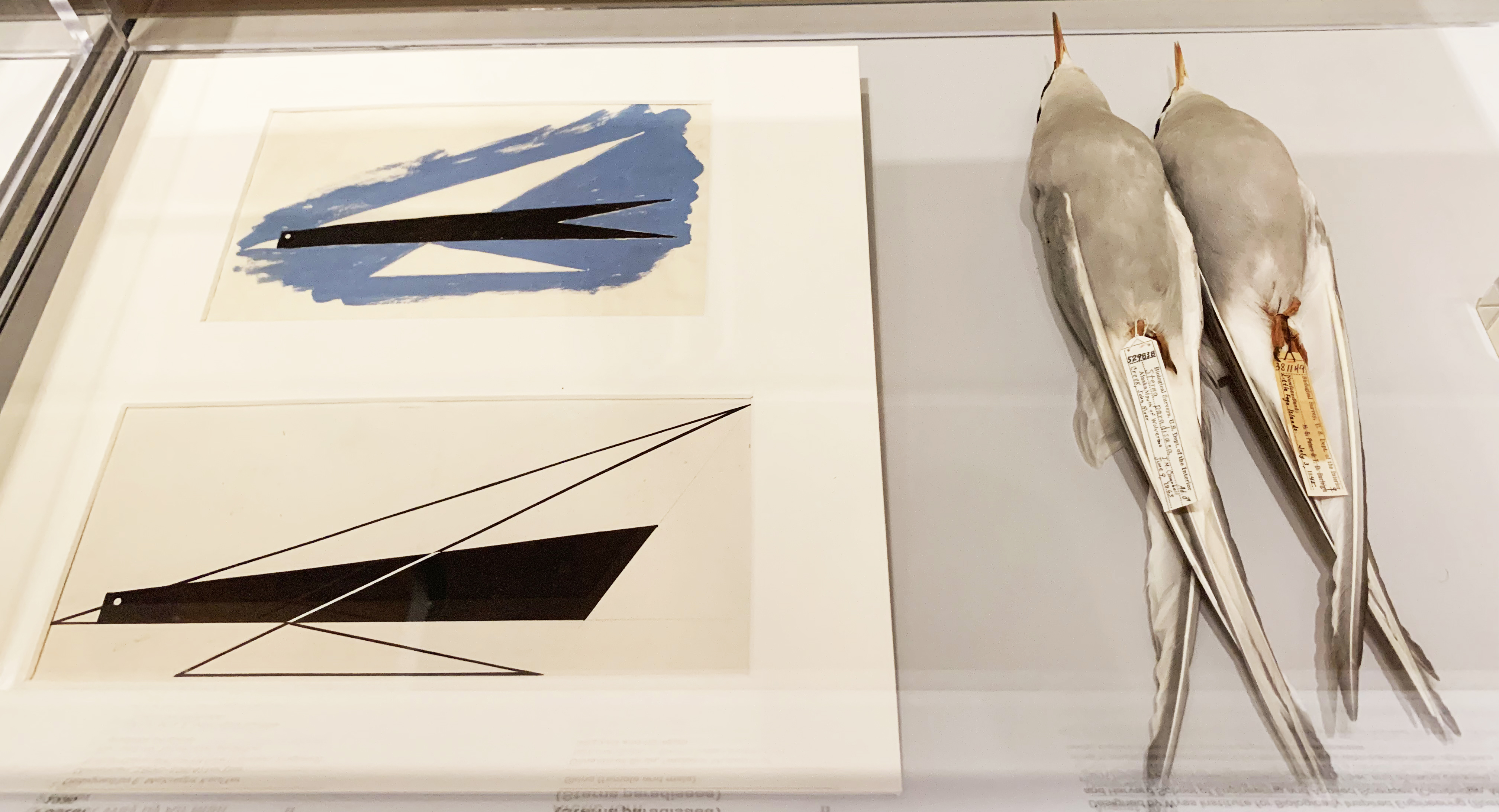
The first-floor permanent exhibition called Rebeca Mendez Selects is pretty unique. As Norman contends we humans are biological animals. We have evolved over millions of years to function well in the environment, to survive. We are analog devices following biological modes of operation. People learn from nature, get inspired by nature. In that exhibition space, many birds specimen are shown by the clear display. From a broad view, the exhibition shows graphic design, fashion design, product design, painting, jewelry design, and those works are all related to the birds’ specimens by imitating its colors and shapes. For example, there is a necklace made by the black feathers, the introduction of it shows, from utilizing real feathers, in the case of Mecky van den Brink’s necklace, to imitating their appearance, as for Tone Vigeland’s hammered-nail necklace, there is no end to the influences of birds on designers. By visiting this museum, people can have a deep understanding of design, not only seeing the beauty of surface but also decoding the visual form because Cooper Hewitt exhibits the process of how to make this design instead of complete results.
Process Lab makes me feel so familiar and moving. It reminds me of the college time being a design student, working all day with materials to find potential usage. The more imaginations designer create, the more ideas will come to their mind. That’s the very beginning of every design project, start with a model, a material and finally make the experiment ideas into real. The Process Lab perfectly shows the process of how to make a design product. It has different colors of papers on the table, the visitors can make their own design style which makes them feel more involved in the design field. Moreover, the video in this lab is also professional. It describes how designers use fabric to develop multiple kinds of textures to make design works.
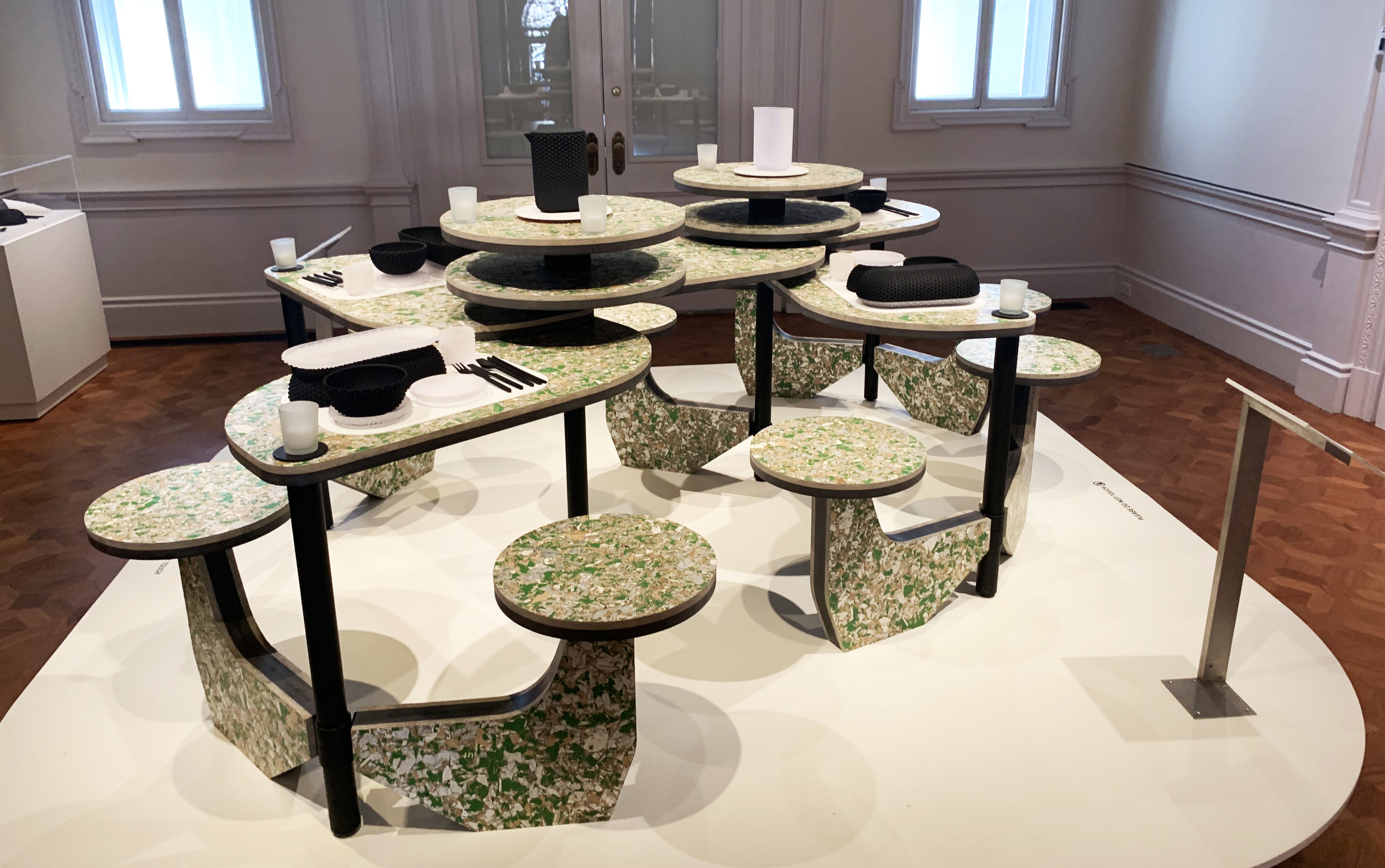
From my perspective, the most treasurable advantage of this museum is that it not only shows the design works but also help people understand design thinking. Another impressive design exhibition is called Table Scapes: Design For Dining. The designer uses rubber material to produce tableware. It has a special texture on the back of the bowl. The colors are very simple, only black and white so that I can’t notice the difference between those products for the first time. By observing the details, I feel very respectful because designers have to think a lot before they make those details. For instance, how to make it more functional, how to improve its beauty. It recalls words said by Paul Rand, the designer of IBM, the design is relationships. In contemporary society, design thinking doesn’t only belong to designers, everyone is equipped with this skill, a way to read and understand the world. To be more specific, the design process can be divided into three basic parts, researching background, finding problems and solutions. Almost all the jobs need researching process before people get into their work. Traditionally, when people talk about design, they think about arts, graphic, beauty. However, the design has become a way to solve multiple problems, including networks and management. In this sense, everything happens has its own value especially the problems.
To sum up, the Cooper Hewitt Museum is unique and professional. It has many masterpieces. Every design exhibition in it with high quality. Also, it makes good use of digital archive in a smart way, to let the visitor bring design works to their home through the internet. I would definitely check the exhibition lists to plan another visit in the future.
Work Cited
“Cooper Hewitt, Smithsonian Design Museum.” Wikipedia, Wikimedia Foundation, 12 Apr. 2019, en.wikipedia.org/wiki/Cooper_Hewitt,_Smithsonian_Design_Museum.
“The Archive” is not an archive: Acknowledging the Intellectual Contributions of Archival Atudies Michelle Caswell
Norman, D. A. (1998). The Invisible Computer: Why Good Products Can Fail, the Personal Computer is So Complex, and Information Appliances are the Solution. MIT Press. Chapter 7: Being Analog
